Audit Strategy for JB Hi Fi Group Pty Limited
VerifiedAdded on 2023/04/21
|16
|4289
|291
AI Summary
This report evaluates the various aspects of audit in relation to JB Hi Fi Group Pty Limited, including corporate, regulatory, accounting, and operational aspects.
Contribute Materials
Your contribution can guide someone’s learning journey. Share your
documents today.
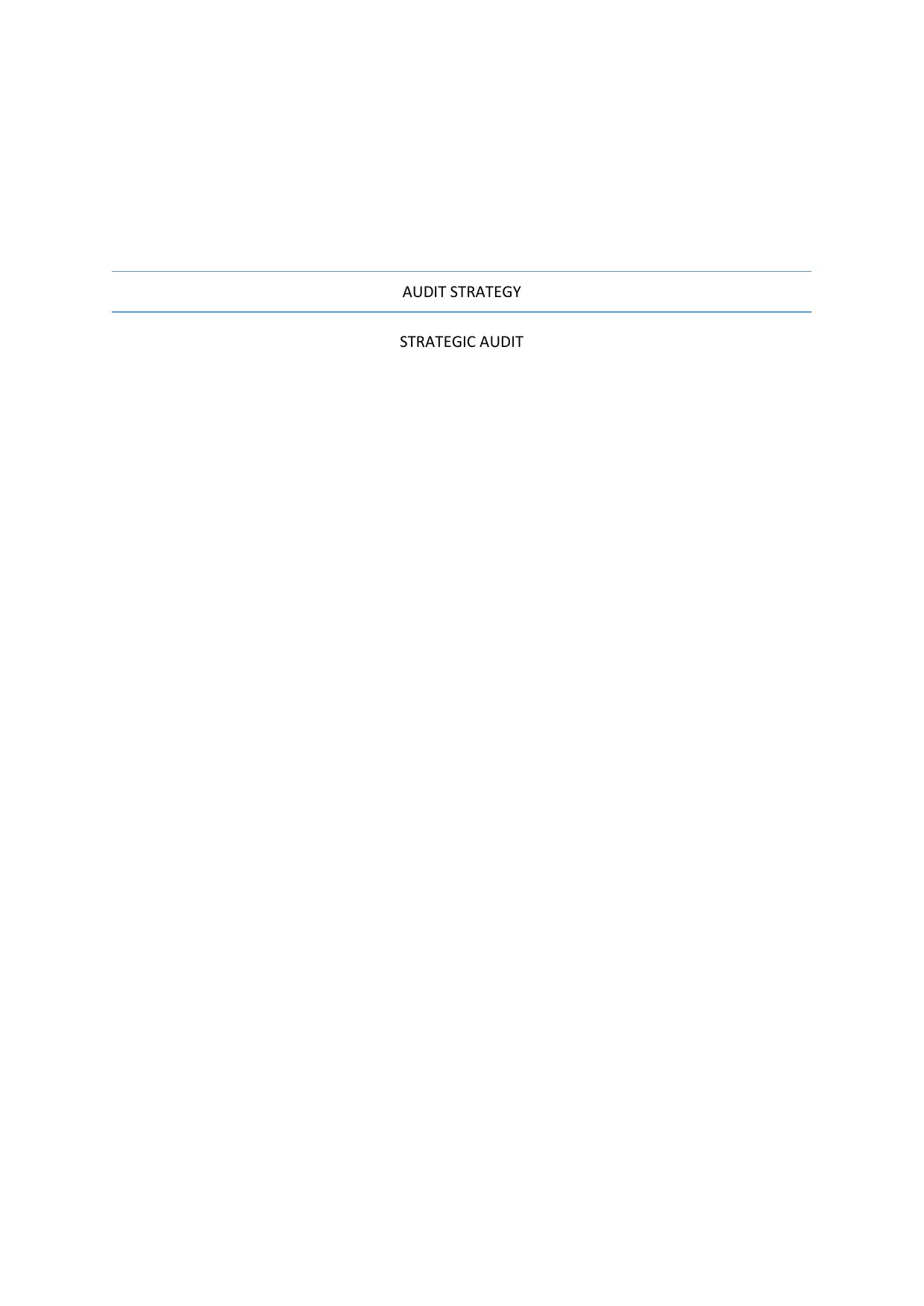
AUDIT STRATEGY
STRATEGIC AUDIT
STRATEGIC AUDIT
Secure Best Marks with AI Grader
Need help grading? Try our AI Grader for instant feedback on your assignments.
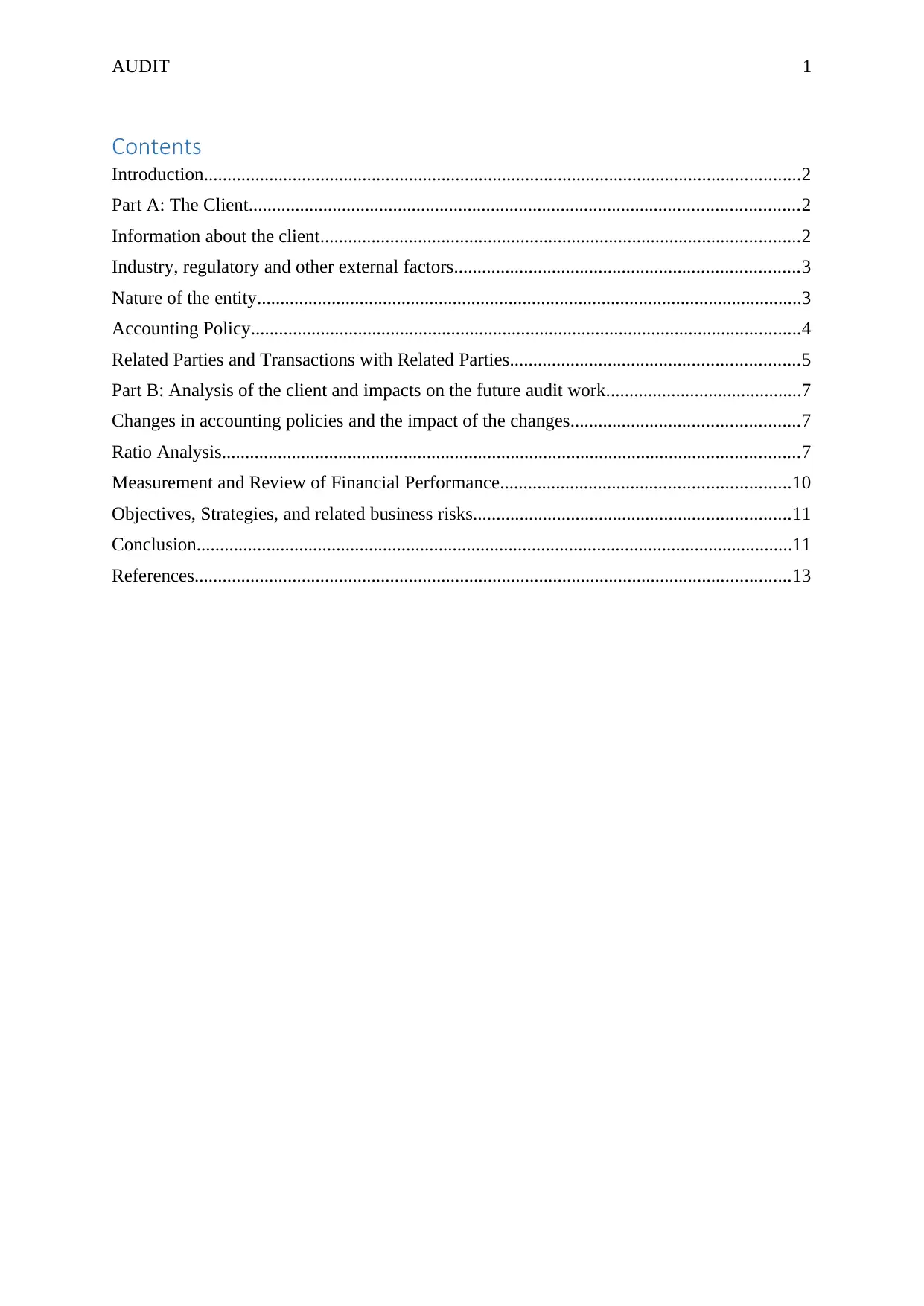
AUDIT 1
Contents
Introduction................................................................................................................................2
Part A: The Client......................................................................................................................2
Information about the client.......................................................................................................2
Industry, regulatory and other external factors..........................................................................3
Nature of the entity.....................................................................................................................3
Accounting Policy......................................................................................................................4
Related Parties and Transactions with Related Parties..............................................................5
Part B: Analysis of the client and impacts on the future audit work..........................................7
Changes in accounting policies and the impact of the changes.................................................7
Ratio Analysis............................................................................................................................7
Measurement and Review of Financial Performance..............................................................10
Objectives, Strategies, and related business risks....................................................................11
Conclusion................................................................................................................................11
References................................................................................................................................13
Contents
Introduction................................................................................................................................2
Part A: The Client......................................................................................................................2
Information about the client.......................................................................................................2
Industry, regulatory and other external factors..........................................................................3
Nature of the entity.....................................................................................................................3
Accounting Policy......................................................................................................................4
Related Parties and Transactions with Related Parties..............................................................5
Part B: Analysis of the client and impacts on the future audit work..........................................7
Changes in accounting policies and the impact of the changes.................................................7
Ratio Analysis............................................................................................................................7
Measurement and Review of Financial Performance..............................................................10
Objectives, Strategies, and related business risks....................................................................11
Conclusion................................................................................................................................11
References................................................................................................................................13
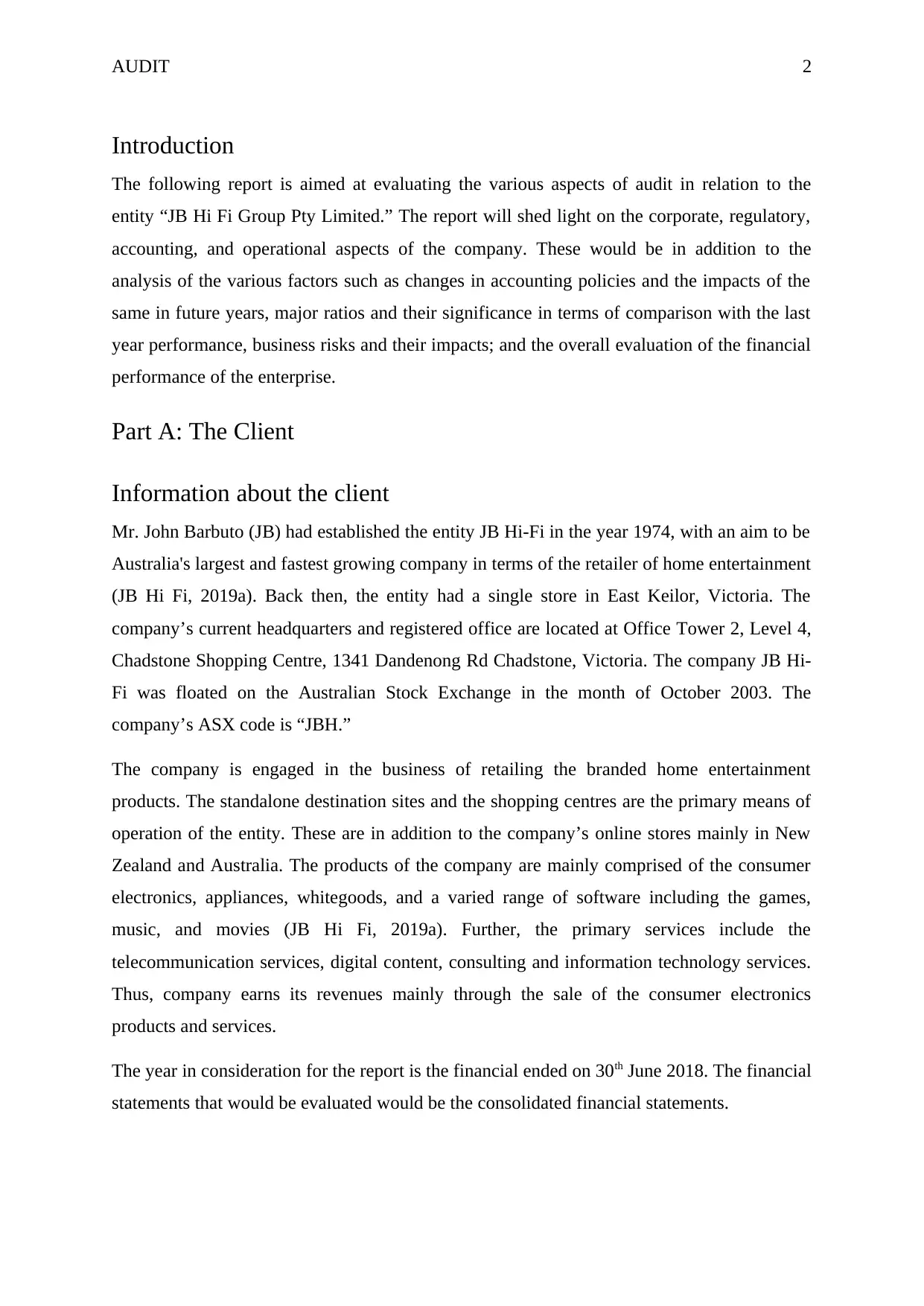
AUDIT 2
Introduction
The following report is aimed at evaluating the various aspects of audit in relation to the
entity “JB Hi Fi Group Pty Limited.” The report will shed light on the corporate, regulatory,
accounting, and operational aspects of the company. These would be in addition to the
analysis of the various factors such as changes in accounting policies and the impacts of the
same in future years, major ratios and their significance in terms of comparison with the last
year performance, business risks and their impacts; and the overall evaluation of the financial
performance of the enterprise.
Part A: The Client
Information about the client
Mr. John Barbuto (JB) had established the entity JB Hi-Fi in the year 1974, with an aim to be
Australia's largest and fastest growing company in terms of the retailer of home entertainment
(JB Hi Fi, 2019a). Back then, the entity had a single store in East Keilor, Victoria. The
company’s current headquarters and registered office are located at Office Tower 2, Level 4,
Chadstone Shopping Centre, 1341 Dandenong Rd Chadstone, Victoria. The company JB Hi-
Fi was floated on the Australian Stock Exchange in the month of October 2003. The
company’s ASX code is “JBH.”
The company is engaged in the business of retailing the branded home entertainment
products. The standalone destination sites and the shopping centres are the primary means of
operation of the entity. These are in addition to the company’s online stores mainly in New
Zealand and Australia. The products of the company are mainly comprised of the consumer
electronics, appliances, whitegoods, and a varied range of software including the games,
music, and movies (JB Hi Fi, 2019a). Further, the primary services include the
telecommunication services, digital content, consulting and information technology services.
Thus, company earns its revenues mainly through the sale of the consumer electronics
products and services.
The year in consideration for the report is the financial ended on 30th June 2018. The financial
statements that would be evaluated would be the consolidated financial statements.
Introduction
The following report is aimed at evaluating the various aspects of audit in relation to the
entity “JB Hi Fi Group Pty Limited.” The report will shed light on the corporate, regulatory,
accounting, and operational aspects of the company. These would be in addition to the
analysis of the various factors such as changes in accounting policies and the impacts of the
same in future years, major ratios and their significance in terms of comparison with the last
year performance, business risks and their impacts; and the overall evaluation of the financial
performance of the enterprise.
Part A: The Client
Information about the client
Mr. John Barbuto (JB) had established the entity JB Hi-Fi in the year 1974, with an aim to be
Australia's largest and fastest growing company in terms of the retailer of home entertainment
(JB Hi Fi, 2019a). Back then, the entity had a single store in East Keilor, Victoria. The
company’s current headquarters and registered office are located at Office Tower 2, Level 4,
Chadstone Shopping Centre, 1341 Dandenong Rd Chadstone, Victoria. The company JB Hi-
Fi was floated on the Australian Stock Exchange in the month of October 2003. The
company’s ASX code is “JBH.”
The company is engaged in the business of retailing the branded home entertainment
products. The standalone destination sites and the shopping centres are the primary means of
operation of the entity. These are in addition to the company’s online stores mainly in New
Zealand and Australia. The products of the company are mainly comprised of the consumer
electronics, appliances, whitegoods, and a varied range of software including the games,
music, and movies (JB Hi Fi, 2019a). Further, the primary services include the
telecommunication services, digital content, consulting and information technology services.
Thus, company earns its revenues mainly through the sale of the consumer electronics
products and services.
The year in consideration for the report is the financial ended on 30th June 2018. The financial
statements that would be evaluated would be the consolidated financial statements.
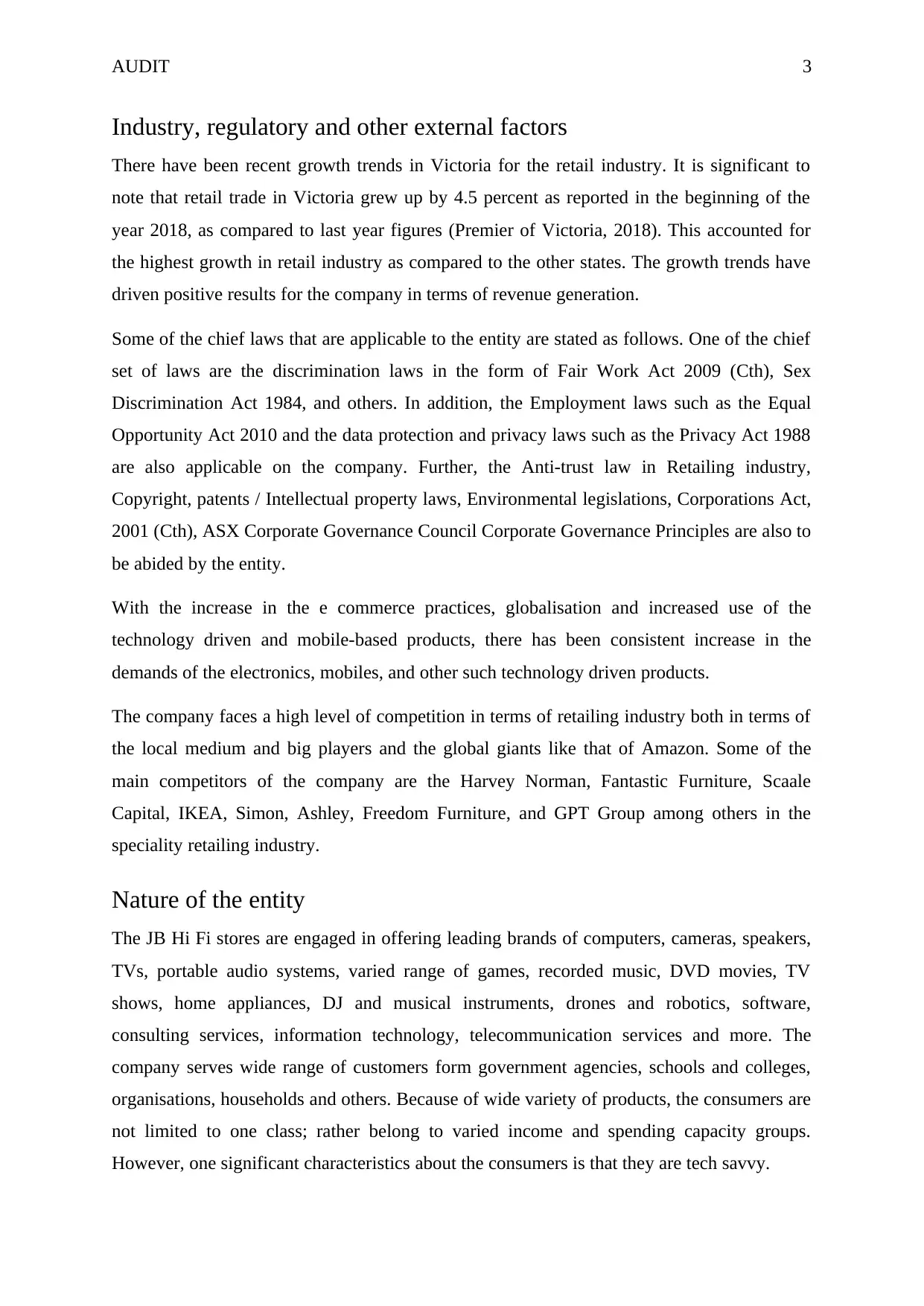
AUDIT 3
Industry, regulatory and other external factors
There have been recent growth trends in Victoria for the retail industry. It is significant to
note that retail trade in Victoria grew up by 4.5 percent as reported in the beginning of the
year 2018, as compared to last year figures (Premier of Victoria, 2018). This accounted for
the highest growth in retail industry as compared to the other states. The growth trends have
driven positive results for the company in terms of revenue generation.
Some of the chief laws that are applicable to the entity are stated as follows. One of the chief
set of laws are the discrimination laws in the form of Fair Work Act 2009 (Cth), Sex
Discrimination Act 1984, and others. In addition, the Employment laws such as the Equal
Opportunity Act 2010 and the data protection and privacy laws such as the Privacy Act 1988
are also applicable on the company. Further, the Anti-trust law in Retailing industry,
Copyright, patents / Intellectual property laws, Environmental legislations, Corporations Act,
2001 (Cth), ASX Corporate Governance Council Corporate Governance Principles are also to
be abided by the entity.
With the increase in the e commerce practices, globalisation and increased use of the
technology driven and mobile-based products, there has been consistent increase in the
demands of the electronics, mobiles, and other such technology driven products.
The company faces a high level of competition in terms of retailing industry both in terms of
the local medium and big players and the global giants like that of Amazon. Some of the
main competitors of the company are the Harvey Norman, Fantastic Furniture, Scaale
Capital, IKEA, Simon, Ashley, Freedom Furniture, and GPT Group among others in the
speciality retailing industry.
Nature of the entity
The JB Hi Fi stores are engaged in offering leading brands of computers, cameras, speakers,
TVs, portable audio systems, varied range of games, recorded music, DVD movies, TV
shows, home appliances, DJ and musical instruments, drones and robotics, software,
consulting services, information technology, telecommunication services and more. The
company serves wide range of customers form government agencies, schools and colleges,
organisations, households and others. Because of wide variety of products, the consumers are
not limited to one class; rather belong to varied income and spending capacity groups.
However, one significant characteristics about the consumers is that they are tech savvy.
Industry, regulatory and other external factors
There have been recent growth trends in Victoria for the retail industry. It is significant to
note that retail trade in Victoria grew up by 4.5 percent as reported in the beginning of the
year 2018, as compared to last year figures (Premier of Victoria, 2018). This accounted for
the highest growth in retail industry as compared to the other states. The growth trends have
driven positive results for the company in terms of revenue generation.
Some of the chief laws that are applicable to the entity are stated as follows. One of the chief
set of laws are the discrimination laws in the form of Fair Work Act 2009 (Cth), Sex
Discrimination Act 1984, and others. In addition, the Employment laws such as the Equal
Opportunity Act 2010 and the data protection and privacy laws such as the Privacy Act 1988
are also applicable on the company. Further, the Anti-trust law in Retailing industry,
Copyright, patents / Intellectual property laws, Environmental legislations, Corporations Act,
2001 (Cth), ASX Corporate Governance Council Corporate Governance Principles are also to
be abided by the entity.
With the increase in the e commerce practices, globalisation and increased use of the
technology driven and mobile-based products, there has been consistent increase in the
demands of the electronics, mobiles, and other such technology driven products.
The company faces a high level of competition in terms of retailing industry both in terms of
the local medium and big players and the global giants like that of Amazon. Some of the
main competitors of the company are the Harvey Norman, Fantastic Furniture, Scaale
Capital, IKEA, Simon, Ashley, Freedom Furniture, and GPT Group among others in the
speciality retailing industry.
Nature of the entity
The JB Hi Fi stores are engaged in offering leading brands of computers, cameras, speakers,
TVs, portable audio systems, varied range of games, recorded music, DVD movies, TV
shows, home appliances, DJ and musical instruments, drones and robotics, software,
consulting services, information technology, telecommunication services and more. The
company serves wide range of customers form government agencies, schools and colleges,
organisations, households and others. Because of wide variety of products, the consumers are
not limited to one class; rather belong to varied income and spending capacity groups.
However, one significant characteristics about the consumers is that they are tech savvy.
Secure Best Marks with AI Grader
Need help grading? Try our AI Grader for instant feedback on your assignments.
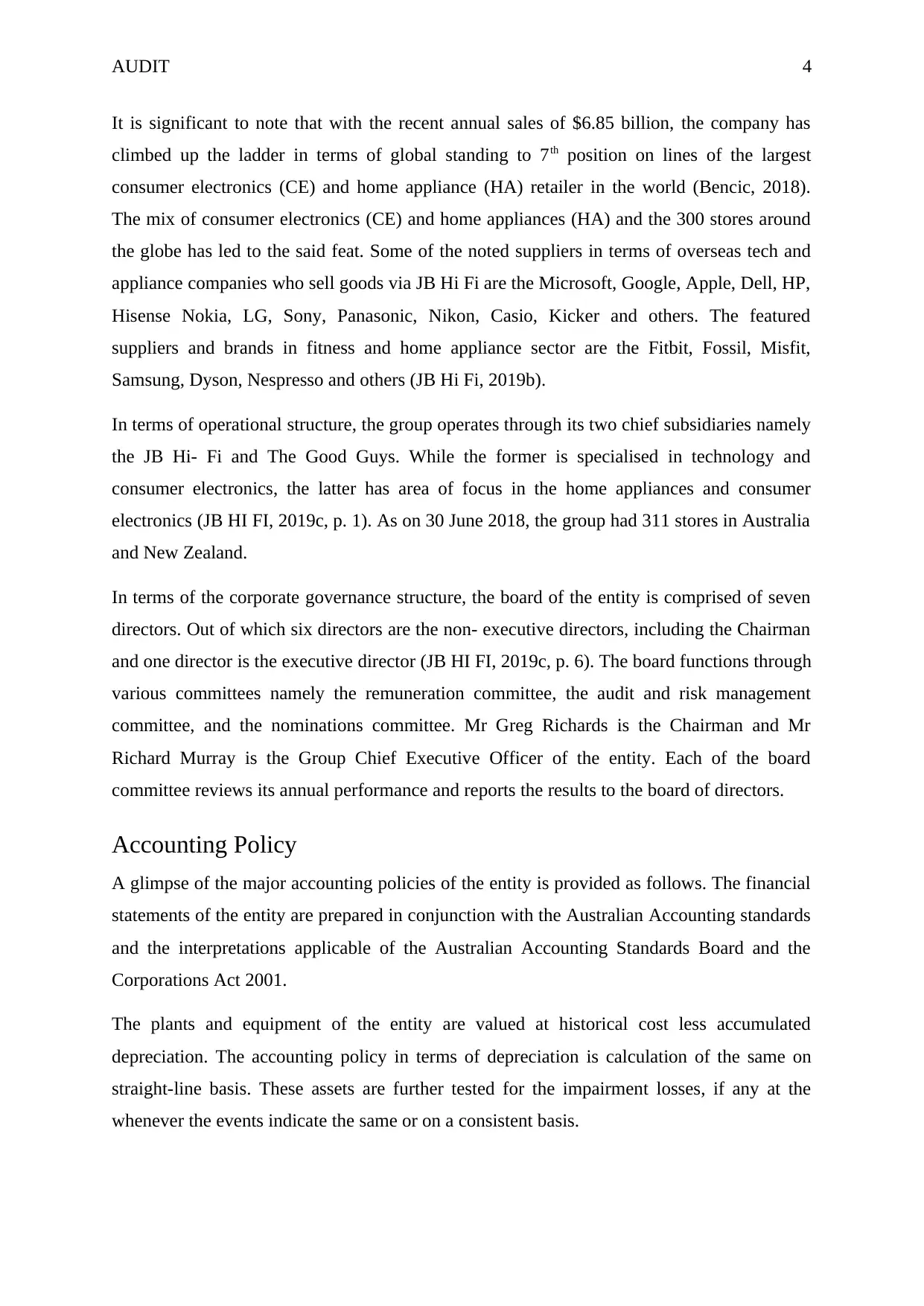
AUDIT 4
It is significant to note that with the recent annual sales of $6.85 billion, the company has
climbed up the ladder in terms of global standing to 7th position on lines of the largest
consumer electronics (CE) and home appliance (HA) retailer in the world (Bencic, 2018).
The mix of consumer electronics (CE) and home appliances (HA) and the 300 stores around
the globe has led to the said feat. Some of the noted suppliers in terms of overseas tech and
appliance companies who sell goods via JB Hi Fi are the Microsoft, Google, Apple, Dell, HP,
Hisense Nokia, LG, Sony, Panasonic, Nikon, Casio, Kicker and others. The featured
suppliers and brands in fitness and home appliance sector are the Fitbit, Fossil, Misfit,
Samsung, Dyson, Nespresso and others (JB Hi Fi, 2019b).
In terms of operational structure, the group operates through its two chief subsidiaries namely
the JB Hi- Fi and The Good Guys. While the former is specialised in technology and
consumer electronics, the latter has area of focus in the home appliances and consumer
electronics (JB HI FI, 2019c, p. 1). As on 30 June 2018, the group had 311 stores in Australia
and New Zealand.
In terms of the corporate governance structure, the board of the entity is comprised of seven
directors. Out of which six directors are the non- executive directors, including the Chairman
and one director is the executive director (JB HI FI, 2019c, p. 6). The board functions through
various committees namely the remuneration committee, the audit and risk management
committee, and the nominations committee. Mr Greg Richards is the Chairman and Mr
Richard Murray is the Group Chief Executive Officer of the entity. Each of the board
committee reviews its annual performance and reports the results to the board of directors.
Accounting Policy
A glimpse of the major accounting policies of the entity is provided as follows. The financial
statements of the entity are prepared in conjunction with the Australian Accounting standards
and the interpretations applicable of the Australian Accounting Standards Board and the
Corporations Act 2001.
The plants and equipment of the entity are valued at historical cost less accumulated
depreciation. The accounting policy in terms of depreciation is calculation of the same on
straight-line basis. These assets are further tested for the impairment losses, if any at the
whenever the events indicate the same or on a consistent basis.
It is significant to note that with the recent annual sales of $6.85 billion, the company has
climbed up the ladder in terms of global standing to 7th position on lines of the largest
consumer electronics (CE) and home appliance (HA) retailer in the world (Bencic, 2018).
The mix of consumer electronics (CE) and home appliances (HA) and the 300 stores around
the globe has led to the said feat. Some of the noted suppliers in terms of overseas tech and
appliance companies who sell goods via JB Hi Fi are the Microsoft, Google, Apple, Dell, HP,
Hisense Nokia, LG, Sony, Panasonic, Nikon, Casio, Kicker and others. The featured
suppliers and brands in fitness and home appliance sector are the Fitbit, Fossil, Misfit,
Samsung, Dyson, Nespresso and others (JB Hi Fi, 2019b).
In terms of operational structure, the group operates through its two chief subsidiaries namely
the JB Hi- Fi and The Good Guys. While the former is specialised in technology and
consumer electronics, the latter has area of focus in the home appliances and consumer
electronics (JB HI FI, 2019c, p. 1). As on 30 June 2018, the group had 311 stores in Australia
and New Zealand.
In terms of the corporate governance structure, the board of the entity is comprised of seven
directors. Out of which six directors are the non- executive directors, including the Chairman
and one director is the executive director (JB HI FI, 2019c, p. 6). The board functions through
various committees namely the remuneration committee, the audit and risk management
committee, and the nominations committee. Mr Greg Richards is the Chairman and Mr
Richard Murray is the Group Chief Executive Officer of the entity. Each of the board
committee reviews its annual performance and reports the results to the board of directors.
Accounting Policy
A glimpse of the major accounting policies of the entity is provided as follows. The financial
statements of the entity are prepared in conjunction with the Australian Accounting standards
and the interpretations applicable of the Australian Accounting Standards Board and the
Corporations Act 2001.
The plants and equipment of the entity are valued at historical cost less accumulated
depreciation. The accounting policy in terms of depreciation is calculation of the same on
straight-line basis. These assets are further tested for the impairment losses, if any at the
whenever the events indicate the same or on a consistent basis.

AUDIT 5
The accounting policy adopted by the entity in terms of valuation of inventory is to measure
them at lower of cost or net realisable value. Further, the company adopts the weighted
average costing method to value the individual items (JB Hi Fi, 2019c, p. 73).
The accounting policy for the accounts receivable is that the credit period offered to the
debtors is that of 30 days. In addition, the entity does not charges any interest on the amounts
of accounts receivables. The company reviews the collectability of the trade receivables at an
ongoing basis (JB Hi Fi, 2019c, p. 74).
In terms of the financial instruments, the entity values its interest rate swaps, interest rate
caps, and foreign currency forward contracts at fair values (JB Hi Fi, 2019c, p. 87).
The entity has an accounting policy to measure the revenues at the fair value of the
consideration that is received or receivable (JB Hi Fi, 2019c, p. 96). The revenues from the
sales are recognised at the time of transferring of the significant risks and rewards to the
buyer. In case of commission, the revenue recognised is the amount of the commission made
by the group as a whole. In relation to the services, the revenues are recognised as per the
portion of the services provided by the entity.
The entity regards the intangible assets to have unlimited useful lives, the same are not
subject to the amortisation and these are regularly tested by the entity for the impairment JB
Hi Fi, 2019c, p. 76).
Related Parties and Transactions with Related Parties
The evaluation and description of the related parties of the entity is as follows.
The parent or the controlling entity of the whole of the group is the JB Hi-Fi Limited, which
is a listed public company, incorporated and based at Australia. The following picture gives
an overall summary of the subsidiaries and the ownership interest in relation to them. The
group company consolidates the assets, liabilities and results of the following principal
subsidiaries.
The accounting policy adopted by the entity in terms of valuation of inventory is to measure
them at lower of cost or net realisable value. Further, the company adopts the weighted
average costing method to value the individual items (JB Hi Fi, 2019c, p. 73).
The accounting policy for the accounts receivable is that the credit period offered to the
debtors is that of 30 days. In addition, the entity does not charges any interest on the amounts
of accounts receivables. The company reviews the collectability of the trade receivables at an
ongoing basis (JB Hi Fi, 2019c, p. 74).
In terms of the financial instruments, the entity values its interest rate swaps, interest rate
caps, and foreign currency forward contracts at fair values (JB Hi Fi, 2019c, p. 87).
The entity has an accounting policy to measure the revenues at the fair value of the
consideration that is received or receivable (JB Hi Fi, 2019c, p. 96). The revenues from the
sales are recognised at the time of transferring of the significant risks and rewards to the
buyer. In case of commission, the revenue recognised is the amount of the commission made
by the group as a whole. In relation to the services, the revenues are recognised as per the
portion of the services provided by the entity.
The entity regards the intangible assets to have unlimited useful lives, the same are not
subject to the amortisation and these are regularly tested by the entity for the impairment JB
Hi Fi, 2019c, p. 76).
Related Parties and Transactions with Related Parties
The evaluation and description of the related parties of the entity is as follows.
The parent or the controlling entity of the whole of the group is the JB Hi-Fi Limited, which
is a listed public company, incorporated and based at Australia. The following picture gives
an overall summary of the subsidiaries and the ownership interest in relation to them. The
group company consolidates the assets, liabilities and results of the following principal
subsidiaries.
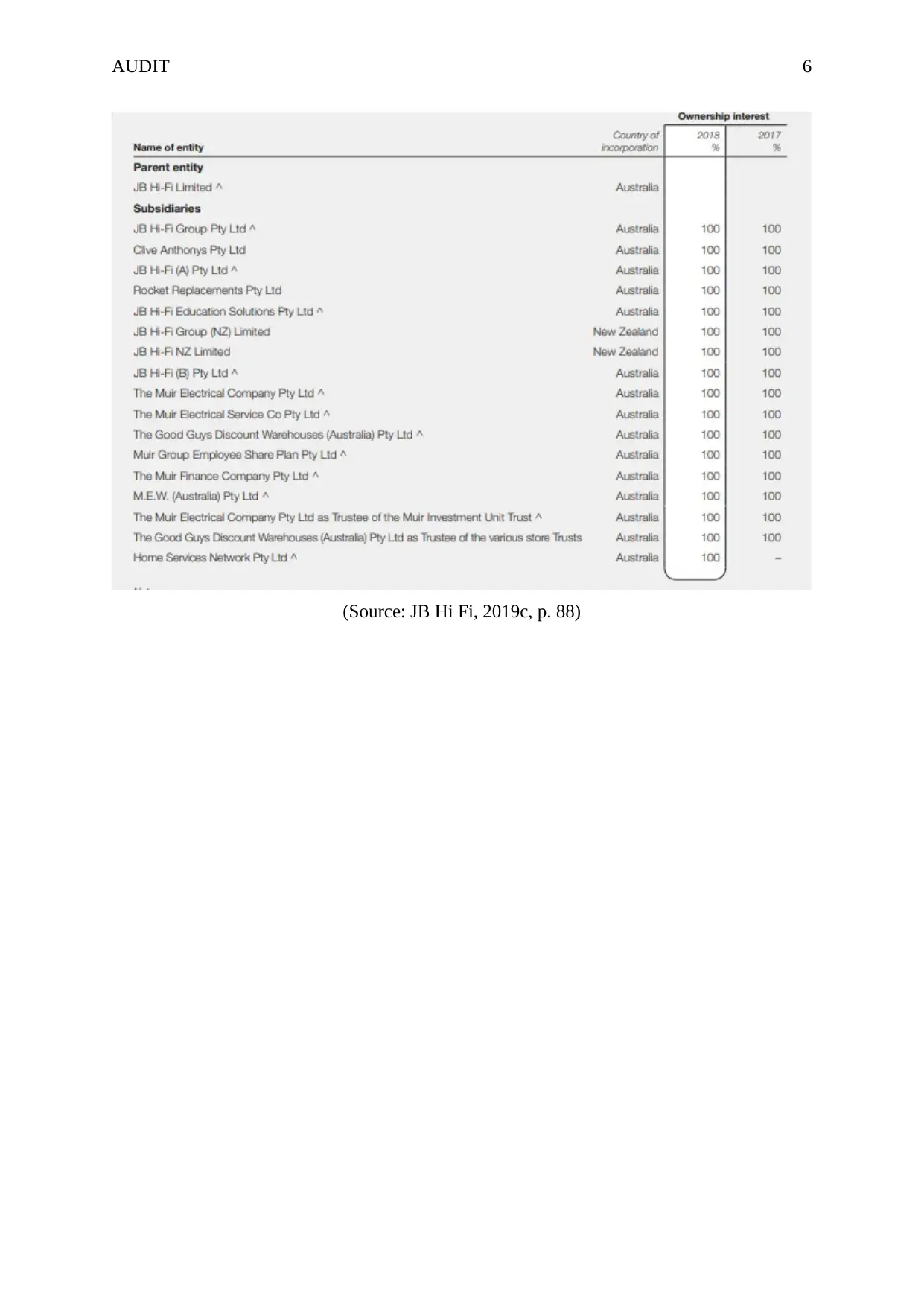
AUDIT 6
(Source: JB Hi Fi, 2019c, p. 88)
(Source: JB Hi Fi, 2019c, p. 88)
Paraphrase This Document
Need a fresh take? Get an instant paraphrase of this document with our AI Paraphraser
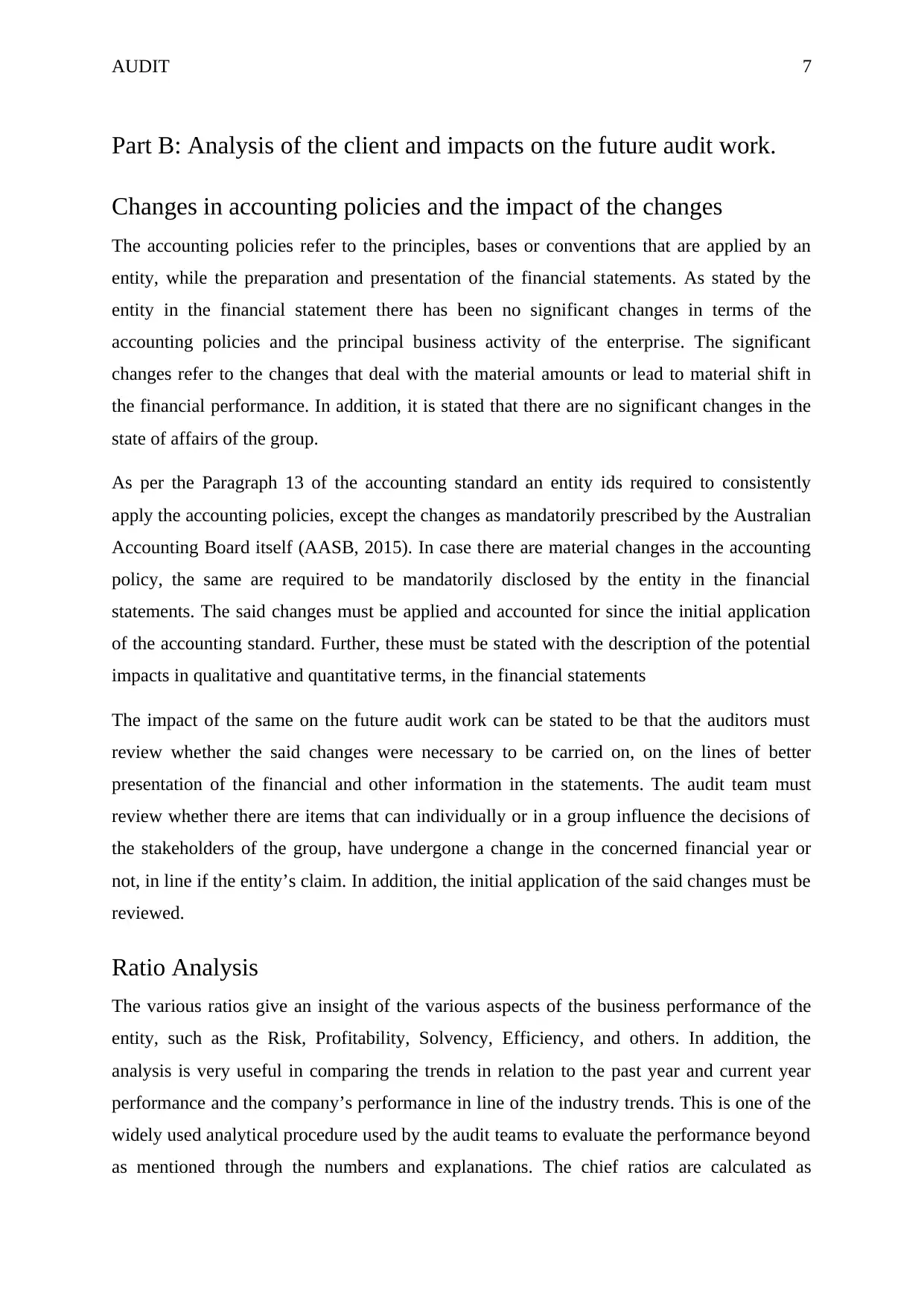
AUDIT 7
Part B: Analysis of the client and impacts on the future audit work.
Changes in accounting policies and the impact of the changes
The accounting policies refer to the principles, bases or conventions that are applied by an
entity, while the preparation and presentation of the financial statements. As stated by the
entity in the financial statement there has been no significant changes in terms of the
accounting policies and the principal business activity of the enterprise. The significant
changes refer to the changes that deal with the material amounts or lead to material shift in
the financial performance. In addition, it is stated that there are no significant changes in the
state of affairs of the group.
As per the Paragraph 13 of the accounting standard an entity ids required to consistently
apply the accounting policies, except the changes as mandatorily prescribed by the Australian
Accounting Board itself (AASB, 2015). In case there are material changes in the accounting
policy, the same are required to be mandatorily disclosed by the entity in the financial
statements. The said changes must be applied and accounted for since the initial application
of the accounting standard. Further, these must be stated with the description of the potential
impacts in qualitative and quantitative terms, in the financial statements
The impact of the same on the future audit work can be stated to be that the auditors must
review whether the said changes were necessary to be carried on, on the lines of better
presentation of the financial and other information in the statements. The audit team must
review whether there are items that can individually or in a group influence the decisions of
the stakeholders of the group, have undergone a change in the concerned financial year or
not, in line if the entity’s claim. In addition, the initial application of the said changes must be
reviewed.
Ratio Analysis
The various ratios give an insight of the various aspects of the business performance of the
entity, such as the Risk, Profitability, Solvency, Efficiency, and others. In addition, the
analysis is very useful in comparing the trends in relation to the past year and current year
performance and the company’s performance in line of the industry trends. This is one of the
widely used analytical procedure used by the audit teams to evaluate the performance beyond
as mentioned through the numbers and explanations. The chief ratios are calculated as
Part B: Analysis of the client and impacts on the future audit work.
Changes in accounting policies and the impact of the changes
The accounting policies refer to the principles, bases or conventions that are applied by an
entity, while the preparation and presentation of the financial statements. As stated by the
entity in the financial statement there has been no significant changes in terms of the
accounting policies and the principal business activity of the enterprise. The significant
changes refer to the changes that deal with the material amounts or lead to material shift in
the financial performance. In addition, it is stated that there are no significant changes in the
state of affairs of the group.
As per the Paragraph 13 of the accounting standard an entity ids required to consistently
apply the accounting policies, except the changes as mandatorily prescribed by the Australian
Accounting Board itself (AASB, 2015). In case there are material changes in the accounting
policy, the same are required to be mandatorily disclosed by the entity in the financial
statements. The said changes must be applied and accounted for since the initial application
of the accounting standard. Further, these must be stated with the description of the potential
impacts in qualitative and quantitative terms, in the financial statements
The impact of the same on the future audit work can be stated to be that the auditors must
review whether the said changes were necessary to be carried on, on the lines of better
presentation of the financial and other information in the statements. The audit team must
review whether there are items that can individually or in a group influence the decisions of
the stakeholders of the group, have undergone a change in the concerned financial year or
not, in line if the entity’s claim. In addition, the initial application of the said changes must be
reviewed.
Ratio Analysis
The various ratios give an insight of the various aspects of the business performance of the
entity, such as the Risk, Profitability, Solvency, Efficiency, and others. In addition, the
analysis is very useful in comparing the trends in relation to the past year and current year
performance and the company’s performance in line of the industry trends. This is one of the
widely used analytical procedure used by the audit teams to evaluate the performance beyond
as mentioned through the numbers and explanations. The chief ratios are calculated as
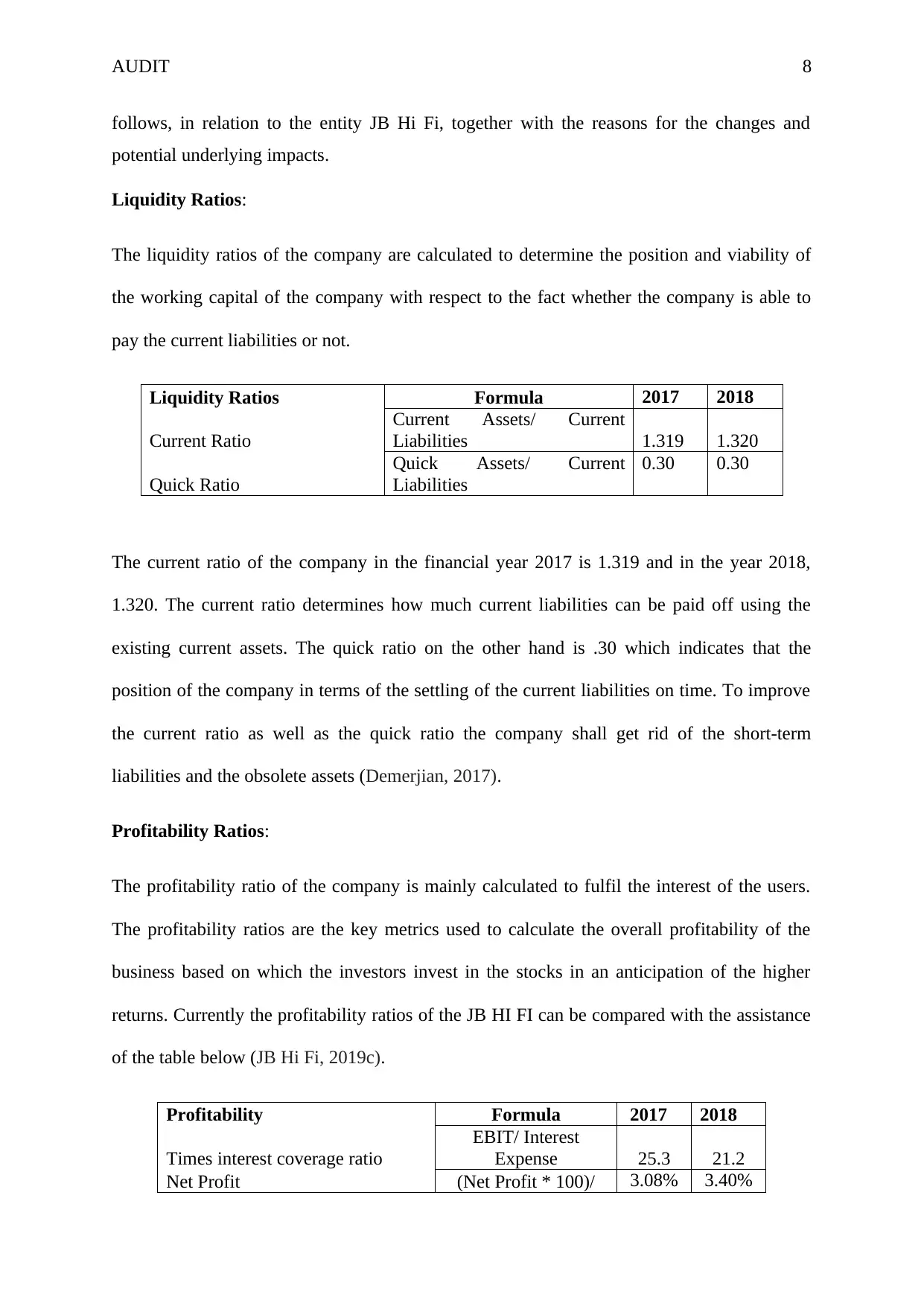
AUDIT 8
follows, in relation to the entity JB Hi Fi, together with the reasons for the changes and
potential underlying impacts.
Liquidity Ratios:
The liquidity ratios of the company are calculated to determine the position and viability of
the working capital of the company with respect to the fact whether the company is able to
pay the current liabilities or not.
Liquidity Ratios Formula 2017 2018
Current Ratio
Current Assets/ Current
Liabilities 1.319 1.320
Quick Ratio
Quick Assets/ Current
Liabilities
0.30 0.30
The current ratio of the company in the financial year 2017 is 1.319 and in the year 2018,
1.320. The current ratio determines how much current liabilities can be paid off using the
existing current assets. The quick ratio on the other hand is .30 which indicates that the
position of the company in terms of the settling of the current liabilities on time. To improve
the current ratio as well as the quick ratio the company shall get rid of the short-term
liabilities and the obsolete assets (Demerjian, 2017).
Profitability Ratios:
The profitability ratio of the company is mainly calculated to fulfil the interest of the users.
The profitability ratios are the key metrics used to calculate the overall profitability of the
business based on which the investors invest in the stocks in an anticipation of the higher
returns. Currently the profitability ratios of the JB HI FI can be compared with the assistance
of the table below (JB Hi Fi, 2019c).
Profitability Formula 2017 2018
Times interest coverage ratio
EBIT/ Interest
Expense 25.3 21.2
Net Profit (Net Profit * 100)/ 3.08% 3.40%
follows, in relation to the entity JB Hi Fi, together with the reasons for the changes and
potential underlying impacts.
Liquidity Ratios:
The liquidity ratios of the company are calculated to determine the position and viability of
the working capital of the company with respect to the fact whether the company is able to
pay the current liabilities or not.
Liquidity Ratios Formula 2017 2018
Current Ratio
Current Assets/ Current
Liabilities 1.319 1.320
Quick Ratio
Quick Assets/ Current
Liabilities
0.30 0.30
The current ratio of the company in the financial year 2017 is 1.319 and in the year 2018,
1.320. The current ratio determines how much current liabilities can be paid off using the
existing current assets. The quick ratio on the other hand is .30 which indicates that the
position of the company in terms of the settling of the current liabilities on time. To improve
the current ratio as well as the quick ratio the company shall get rid of the short-term
liabilities and the obsolete assets (Demerjian, 2017).
Profitability Ratios:
The profitability ratio of the company is mainly calculated to fulfil the interest of the users.
The profitability ratios are the key metrics used to calculate the overall profitability of the
business based on which the investors invest in the stocks in an anticipation of the higher
returns. Currently the profitability ratios of the JB HI FI can be compared with the assistance
of the table below (JB Hi Fi, 2019c).
Profitability Formula 2017 2018
Times interest coverage ratio
EBIT/ Interest
Expense 25.3 21.2
Net Profit (Net Profit * 100)/ 3.08% 3.40%

AUDIT 9
Net Sales
The net profit margin set by the company is very low in both the years between 3.08% to
3.405. JB HI FI shall focus on increasing in the profit margins to set an example in the market
and to grab the greater market share. On the other hand the times interest coverage ratio, is
the ratio that reflects the capacity of the firm to pay back the interest with the usage of the
earnings earned by the company. In the year 2017 the times interest coverage ratio is 25.3 and
it fell down to 21.2 times hence the company must take note of the interest expenses and shall
reduce the same (Kieso, Weygandt and Warfield, 2016).
Solvency Ratios
Solvency ratios of the JB HI FI include the debt to equity ratio and the debt to total assets
ratio. The debt to equity ratio of the company is 1.88 in the year 2017 and it reduced to the
year 1.63. This indicates that the company is able to pay the long term debt and is more
interested in the financing through equity. The debt to the total assets of the company
describes how well the company is able to finance the assets. The debt to total assets fell
down from 0.65 to 0.62 and according to the ideal ratio the debt to asset ratio shall be lower
than 0.4 as too much debt financing will account for more leverage on the company (Beaver,
2018).
Solvency ratios Formula 2017 2018
Debt to Equity Debt/ Equity 1.88 1.63
Debt to Total Assets Debt/ Total Assets 0.65 0.62
Activity ratios
The activity ratios of the JB HI FI are inclusive of the day’s inventory outstanding which
determines the ability of the company to recover the debtors of the company. Earlier the
Net Sales
The net profit margin set by the company is very low in both the years between 3.08% to
3.405. JB HI FI shall focus on increasing in the profit margins to set an example in the market
and to grab the greater market share. On the other hand the times interest coverage ratio, is
the ratio that reflects the capacity of the firm to pay back the interest with the usage of the
earnings earned by the company. In the year 2017 the times interest coverage ratio is 25.3 and
it fell down to 21.2 times hence the company must take note of the interest expenses and shall
reduce the same (Kieso, Weygandt and Warfield, 2016).
Solvency Ratios
Solvency ratios of the JB HI FI include the debt to equity ratio and the debt to total assets
ratio. The debt to equity ratio of the company is 1.88 in the year 2017 and it reduced to the
year 1.63. This indicates that the company is able to pay the long term debt and is more
interested in the financing through equity. The debt to the total assets of the company
describes how well the company is able to finance the assets. The debt to total assets fell
down from 0.65 to 0.62 and according to the ideal ratio the debt to asset ratio shall be lower
than 0.4 as too much debt financing will account for more leverage on the company (Beaver,
2018).
Solvency ratios Formula 2017 2018
Debt to Equity Debt/ Equity 1.88 1.63
Debt to Total Assets Debt/ Total Assets 0.65 0.62
Activity ratios
The activity ratios of the JB HI FI are inclusive of the day’s inventory outstanding which
determines the ability of the company to recover the debtors of the company. Earlier the
Secure Best Marks with AI Grader
Need help grading? Try our AI Grader for instant feedback on your assignments.
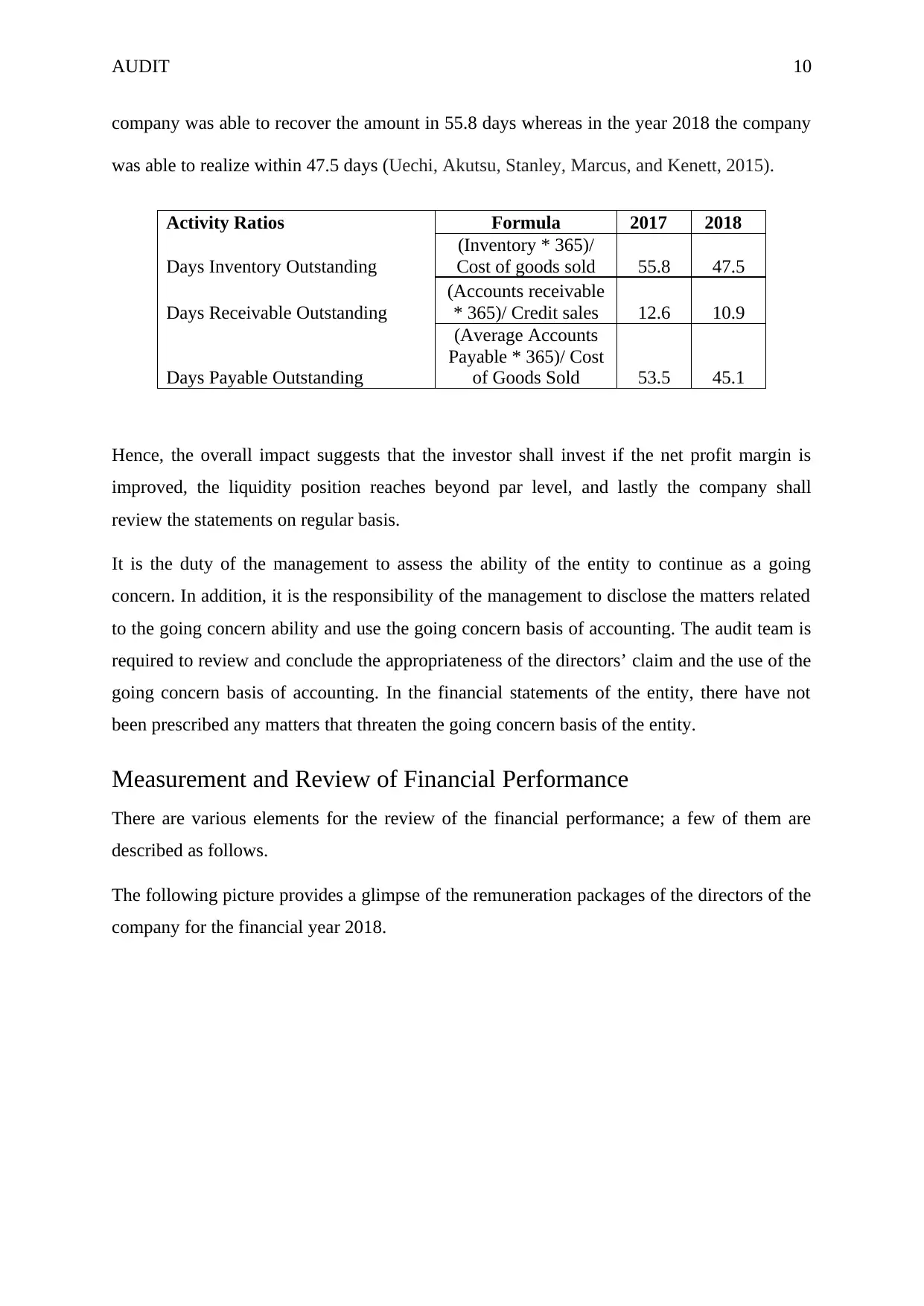
AUDIT 10
company was able to recover the amount in 55.8 days whereas in the year 2018 the company
was able to realize within 47.5 days (Uechi, Akutsu, Stanley, Marcus, and Kenett, 2015).
Activity Ratios Formula 2017 2018
Days Inventory Outstanding
(Inventory * 365)/
Cost of goods sold 55.8 47.5
Days Receivable Outstanding
(Accounts receivable
* 365)/ Credit sales 12.6 10.9
Days Payable Outstanding
(Average Accounts
Payable * 365)/ Cost
of Goods Sold 53.5 45.1
Hence, the overall impact suggests that the investor shall invest if the net profit margin is
improved, the liquidity position reaches beyond par level, and lastly the company shall
review the statements on regular basis.
It is the duty of the management to assess the ability of the entity to continue as a going
concern. In addition, it is the responsibility of the management to disclose the matters related
to the going concern ability and use the going concern basis of accounting. The audit team is
required to review and conclude the appropriateness of the directors’ claim and the use of the
going concern basis of accounting. In the financial statements of the entity, there have not
been prescribed any matters that threaten the going concern basis of the entity.
Measurement and Review of Financial Performance
There are various elements for the review of the financial performance; a few of them are
described as follows.
The following picture provides a glimpse of the remuneration packages of the directors of the
company for the financial year 2018.
company was able to recover the amount in 55.8 days whereas in the year 2018 the company
was able to realize within 47.5 days (Uechi, Akutsu, Stanley, Marcus, and Kenett, 2015).
Activity Ratios Formula 2017 2018
Days Inventory Outstanding
(Inventory * 365)/
Cost of goods sold 55.8 47.5
Days Receivable Outstanding
(Accounts receivable
* 365)/ Credit sales 12.6 10.9
Days Payable Outstanding
(Average Accounts
Payable * 365)/ Cost
of Goods Sold 53.5 45.1
Hence, the overall impact suggests that the investor shall invest if the net profit margin is
improved, the liquidity position reaches beyond par level, and lastly the company shall
review the statements on regular basis.
It is the duty of the management to assess the ability of the entity to continue as a going
concern. In addition, it is the responsibility of the management to disclose the matters related
to the going concern ability and use the going concern basis of accounting. The audit team is
required to review and conclude the appropriateness of the directors’ claim and the use of the
going concern basis of accounting. In the financial statements of the entity, there have not
been prescribed any matters that threaten the going concern basis of the entity.
Measurement and Review of Financial Performance
There are various elements for the review of the financial performance; a few of them are
described as follows.
The following picture provides a glimpse of the remuneration packages of the directors of the
company for the financial year 2018.
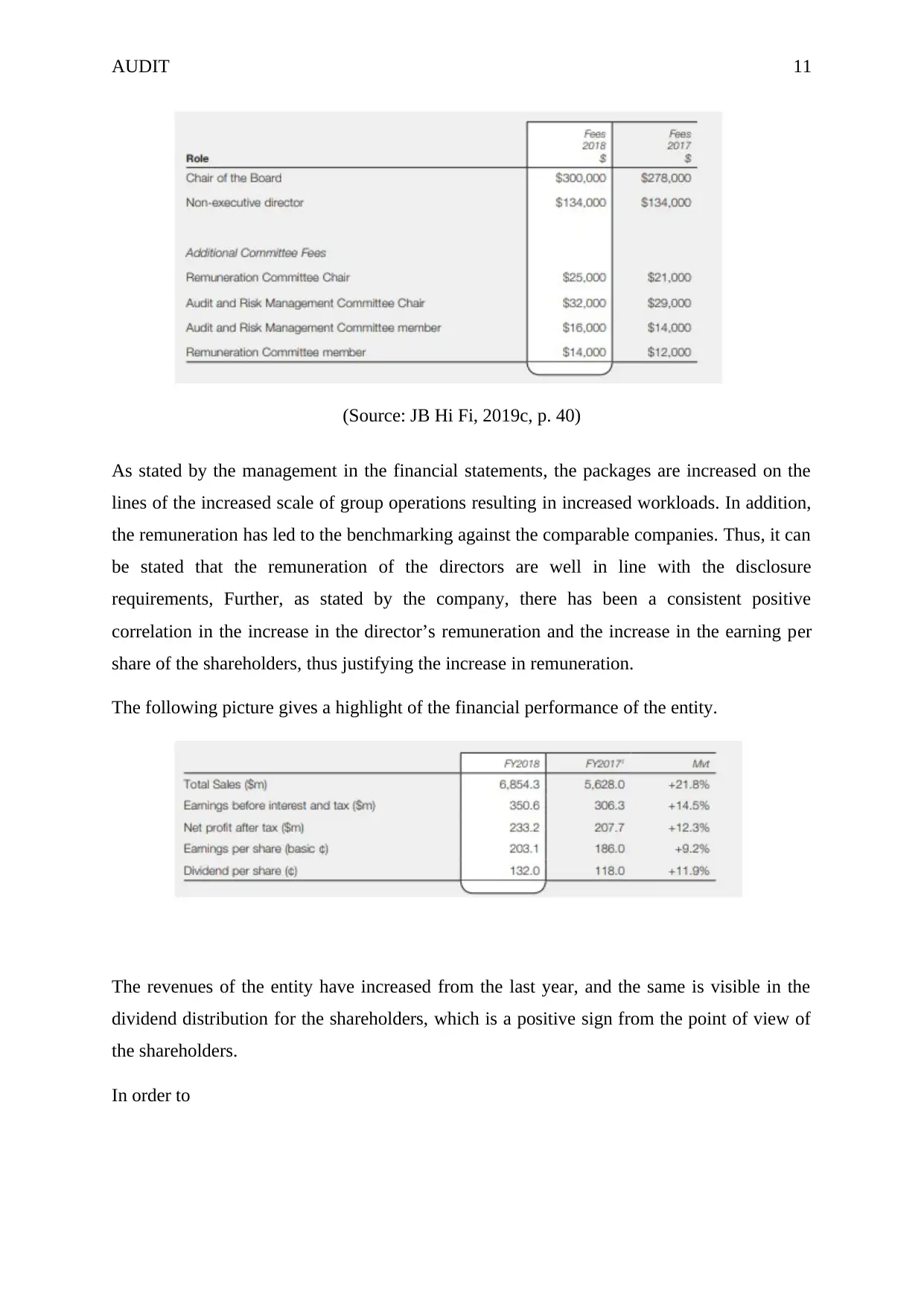
AUDIT 11
(Source: JB Hi Fi, 2019c, p. 40)
As stated by the management in the financial statements, the packages are increased on the
lines of the increased scale of group operations resulting in increased workloads. In addition,
the remuneration has led to the benchmarking against the comparable companies. Thus, it can
be stated that the remuneration of the directors are well in line with the disclosure
requirements, Further, as stated by the company, there has been a consistent positive
correlation in the increase in the director’s remuneration and the increase in the earning per
share of the shareholders, thus justifying the increase in remuneration.
The following picture gives a highlight of the financial performance of the entity.
The revenues of the entity have increased from the last year, and the same is visible in the
dividend distribution for the shareholders, which is a positive sign from the point of view of
the shareholders.
In order to
(Source: JB Hi Fi, 2019c, p. 40)
As stated by the management in the financial statements, the packages are increased on the
lines of the increased scale of group operations resulting in increased workloads. In addition,
the remuneration has led to the benchmarking against the comparable companies. Thus, it can
be stated that the remuneration of the directors are well in line with the disclosure
requirements, Further, as stated by the company, there has been a consistent positive
correlation in the increase in the director’s remuneration and the increase in the earning per
share of the shareholders, thus justifying the increase in remuneration.
The following picture gives a highlight of the financial performance of the entity.
The revenues of the entity have increased from the last year, and the same is visible in the
dividend distribution for the shareholders, which is a positive sign from the point of view of
the shareholders.
In order to
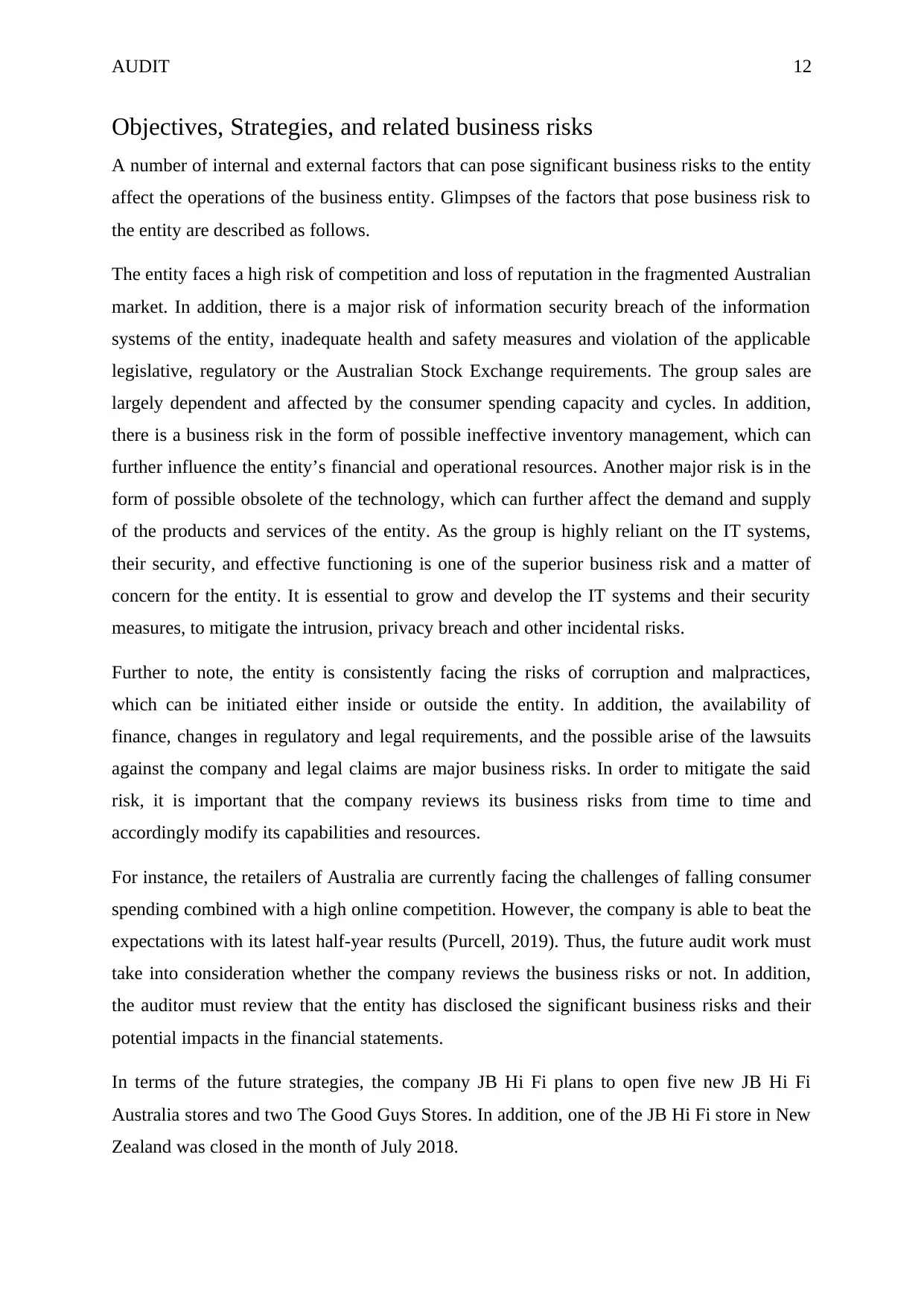
AUDIT 12
Objectives, Strategies, and related business risks
A number of internal and external factors that can pose significant business risks to the entity
affect the operations of the business entity. Glimpses of the factors that pose business risk to
the entity are described as follows.
The entity faces a high risk of competition and loss of reputation in the fragmented Australian
market. In addition, there is a major risk of information security breach of the information
systems of the entity, inadequate health and safety measures and violation of the applicable
legislative, regulatory or the Australian Stock Exchange requirements. The group sales are
largely dependent and affected by the consumer spending capacity and cycles. In addition,
there is a business risk in the form of possible ineffective inventory management, which can
further influence the entity’s financial and operational resources. Another major risk is in the
form of possible obsolete of the technology, which can further affect the demand and supply
of the products and services of the entity. As the group is highly reliant on the IT systems,
their security, and effective functioning is one of the superior business risk and a matter of
concern for the entity. It is essential to grow and develop the IT systems and their security
measures, to mitigate the intrusion, privacy breach and other incidental risks.
Further to note, the entity is consistently facing the risks of corruption and malpractices,
which can be initiated either inside or outside the entity. In addition, the availability of
finance, changes in regulatory and legal requirements, and the possible arise of the lawsuits
against the company and legal claims are major business risks. In order to mitigate the said
risk, it is important that the company reviews its business risks from time to time and
accordingly modify its capabilities and resources.
For instance, the retailers of Australia are currently facing the challenges of falling consumer
spending combined with a high online competition. However, the company is able to beat the
expectations with its latest half-year results (Purcell, 2019). Thus, the future audit work must
take into consideration whether the company reviews the business risks or not. In addition,
the auditor must review that the entity has disclosed the significant business risks and their
potential impacts in the financial statements.
In terms of the future strategies, the company JB Hi Fi plans to open five new JB Hi Fi
Australia stores and two The Good Guys Stores. In addition, one of the JB Hi Fi store in New
Zealand was closed in the month of July 2018.
Objectives, Strategies, and related business risks
A number of internal and external factors that can pose significant business risks to the entity
affect the operations of the business entity. Glimpses of the factors that pose business risk to
the entity are described as follows.
The entity faces a high risk of competition and loss of reputation in the fragmented Australian
market. In addition, there is a major risk of information security breach of the information
systems of the entity, inadequate health and safety measures and violation of the applicable
legislative, regulatory or the Australian Stock Exchange requirements. The group sales are
largely dependent and affected by the consumer spending capacity and cycles. In addition,
there is a business risk in the form of possible ineffective inventory management, which can
further influence the entity’s financial and operational resources. Another major risk is in the
form of possible obsolete of the technology, which can further affect the demand and supply
of the products and services of the entity. As the group is highly reliant on the IT systems,
their security, and effective functioning is one of the superior business risk and a matter of
concern for the entity. It is essential to grow and develop the IT systems and their security
measures, to mitigate the intrusion, privacy breach and other incidental risks.
Further to note, the entity is consistently facing the risks of corruption and malpractices,
which can be initiated either inside or outside the entity. In addition, the availability of
finance, changes in regulatory and legal requirements, and the possible arise of the lawsuits
against the company and legal claims are major business risks. In order to mitigate the said
risk, it is important that the company reviews its business risks from time to time and
accordingly modify its capabilities and resources.
For instance, the retailers of Australia are currently facing the challenges of falling consumer
spending combined with a high online competition. However, the company is able to beat the
expectations with its latest half-year results (Purcell, 2019). Thus, the future audit work must
take into consideration whether the company reviews the business risks or not. In addition,
the auditor must review that the entity has disclosed the significant business risks and their
potential impacts in the financial statements.
In terms of the future strategies, the company JB Hi Fi plans to open five new JB Hi Fi
Australia stores and two The Good Guys Stores. In addition, one of the JB Hi Fi store in New
Zealand was closed in the month of July 2018.
Paraphrase This Document
Need a fresh take? Get an instant paraphrase of this document with our AI Paraphraser
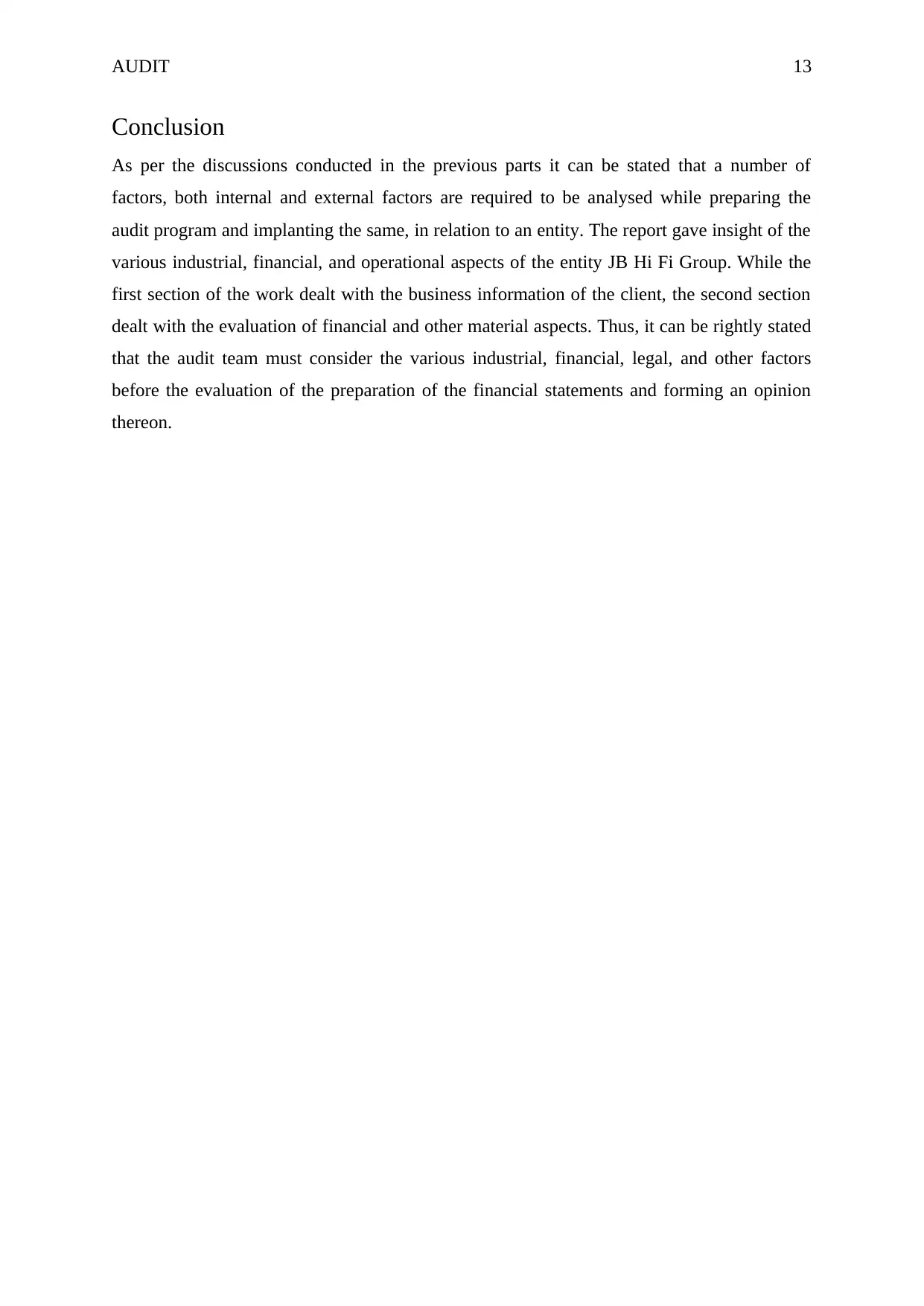
AUDIT 13
Conclusion
As per the discussions conducted in the previous parts it can be stated that a number of
factors, both internal and external factors are required to be analysed while preparing the
audit program and implanting the same, in relation to an entity. The report gave insight of the
various industrial, financial, and operational aspects of the entity JB Hi Fi Group. While the
first section of the work dealt with the business information of the client, the second section
dealt with the evaluation of financial and other material aspects. Thus, it can be rightly stated
that the audit team must consider the various industrial, financial, legal, and other factors
before the evaluation of the preparation of the financial statements and forming an opinion
thereon.
Conclusion
As per the discussions conducted in the previous parts it can be stated that a number of
factors, both internal and external factors are required to be analysed while preparing the
audit program and implanting the same, in relation to an entity. The report gave insight of the
various industrial, financial, and operational aspects of the entity JB Hi Fi Group. While the
first section of the work dealt with the business information of the client, the second section
dealt with the evaluation of financial and other material aspects. Thus, it can be rightly stated
that the audit team must consider the various industrial, financial, legal, and other factors
before the evaluation of the preparation of the financial statements and forming an opinion
thereon.
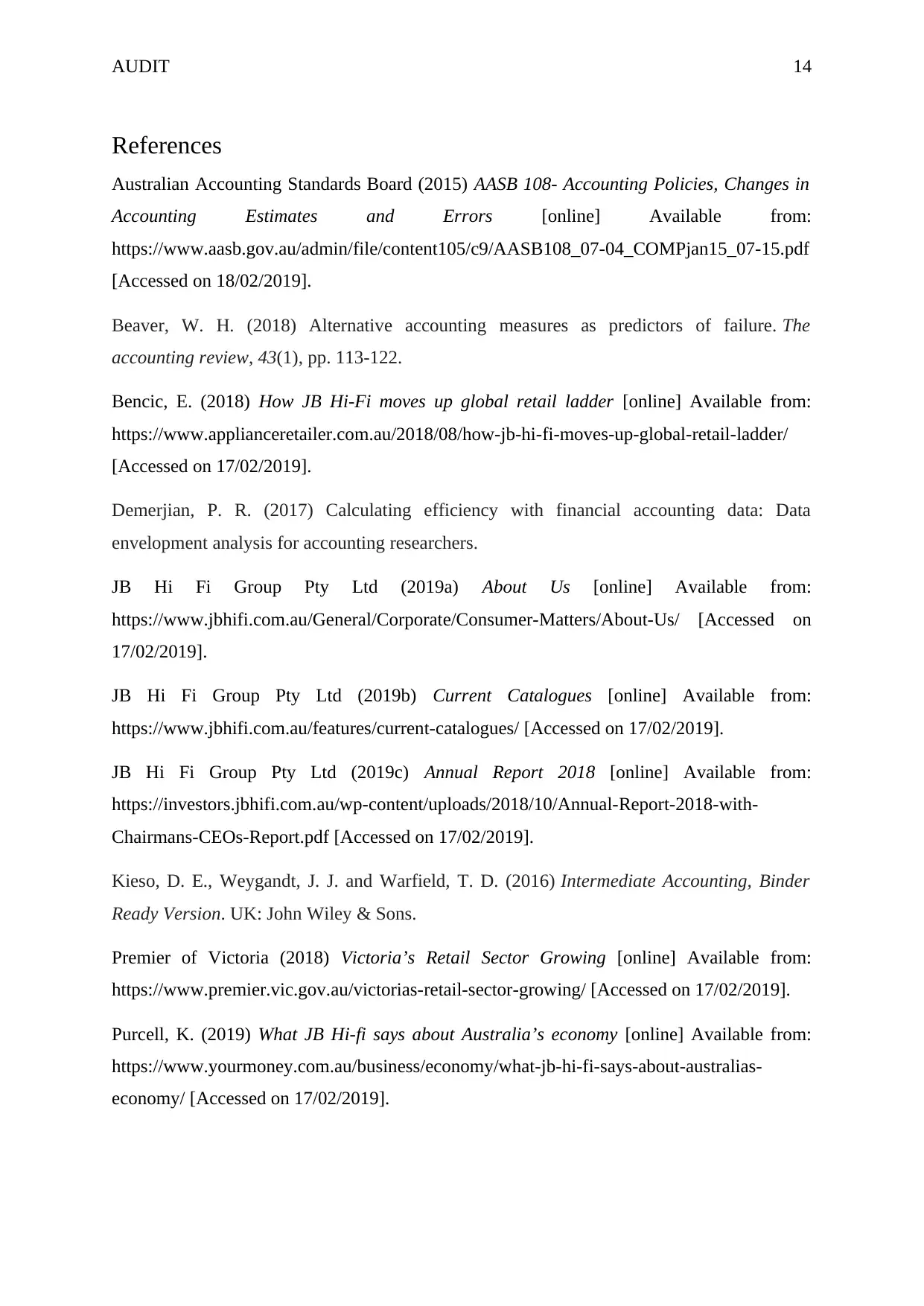
AUDIT 14
References
Australian Accounting Standards Board (2015) AASB 108- Accounting Policies, Changes in
Accounting Estimates and Errors [online] Available from:
https://www.aasb.gov.au/admin/file/content105/c9/AASB108_07-04_COMPjan15_07-15.pdf
[Accessed on 18/02/2019].
Beaver, W. H. (2018) Alternative accounting measures as predictors of failure. The
accounting review, 43(1), pp. 113-122.
Bencic, E. (2018) How JB Hi-Fi moves up global retail ladder [online] Available from:
https://www.applianceretailer.com.au/2018/08/how-jb-hi-fi-moves-up-global-retail-ladder/
[Accessed on 17/02/2019].
Demerjian, P. R. (2017) Calculating efficiency with financial accounting data: Data
envelopment analysis for accounting researchers.
JB Hi Fi Group Pty Ltd (2019a) About Us [online] Available from:
https://www.jbhifi.com.au/General/Corporate/Consumer-Matters/About-Us/ [Accessed on
17/02/2019].
JB Hi Fi Group Pty Ltd (2019b) Current Catalogues [online] Available from:
https://www.jbhifi.com.au/features/current-catalogues/ [Accessed on 17/02/2019].
JB Hi Fi Group Pty Ltd (2019c) Annual Report 2018 [online] Available from:
https://investors.jbhifi.com.au/wp-content/uploads/2018/10/Annual-Report-2018-with-
Chairmans-CEOs-Report.pdf [Accessed on 17/02/2019].
Kieso, D. E., Weygandt, J. J. and Warfield, T. D. (2016) Intermediate Accounting, Binder
Ready Version. UK: John Wiley & Sons.
Premier of Victoria (2018) Victoria’s Retail Sector Growing [online] Available from:
https://www.premier.vic.gov.au/victorias-retail-sector-growing/ [Accessed on 17/02/2019].
Purcell, K. (2019) What JB Hi-fi says about Australia’s economy [online] Available from:
https://www.yourmoney.com.au/business/economy/what-jb-hi-fi-says-about-australias-
economy/ [Accessed on 17/02/2019].
References
Australian Accounting Standards Board (2015) AASB 108- Accounting Policies, Changes in
Accounting Estimates and Errors [online] Available from:
https://www.aasb.gov.au/admin/file/content105/c9/AASB108_07-04_COMPjan15_07-15.pdf
[Accessed on 18/02/2019].
Beaver, W. H. (2018) Alternative accounting measures as predictors of failure. The
accounting review, 43(1), pp. 113-122.
Bencic, E. (2018) How JB Hi-Fi moves up global retail ladder [online] Available from:
https://www.applianceretailer.com.au/2018/08/how-jb-hi-fi-moves-up-global-retail-ladder/
[Accessed on 17/02/2019].
Demerjian, P. R. (2017) Calculating efficiency with financial accounting data: Data
envelopment analysis for accounting researchers.
JB Hi Fi Group Pty Ltd (2019a) About Us [online] Available from:
https://www.jbhifi.com.au/General/Corporate/Consumer-Matters/About-Us/ [Accessed on
17/02/2019].
JB Hi Fi Group Pty Ltd (2019b) Current Catalogues [online] Available from:
https://www.jbhifi.com.au/features/current-catalogues/ [Accessed on 17/02/2019].
JB Hi Fi Group Pty Ltd (2019c) Annual Report 2018 [online] Available from:
https://investors.jbhifi.com.au/wp-content/uploads/2018/10/Annual-Report-2018-with-
Chairmans-CEOs-Report.pdf [Accessed on 17/02/2019].
Kieso, D. E., Weygandt, J. J. and Warfield, T. D. (2016) Intermediate Accounting, Binder
Ready Version. UK: John Wiley & Sons.
Premier of Victoria (2018) Victoria’s Retail Sector Growing [online] Available from:
https://www.premier.vic.gov.au/victorias-retail-sector-growing/ [Accessed on 17/02/2019].
Purcell, K. (2019) What JB Hi-fi says about Australia’s economy [online] Available from:
https://www.yourmoney.com.au/business/economy/what-jb-hi-fi-says-about-australias-
economy/ [Accessed on 17/02/2019].
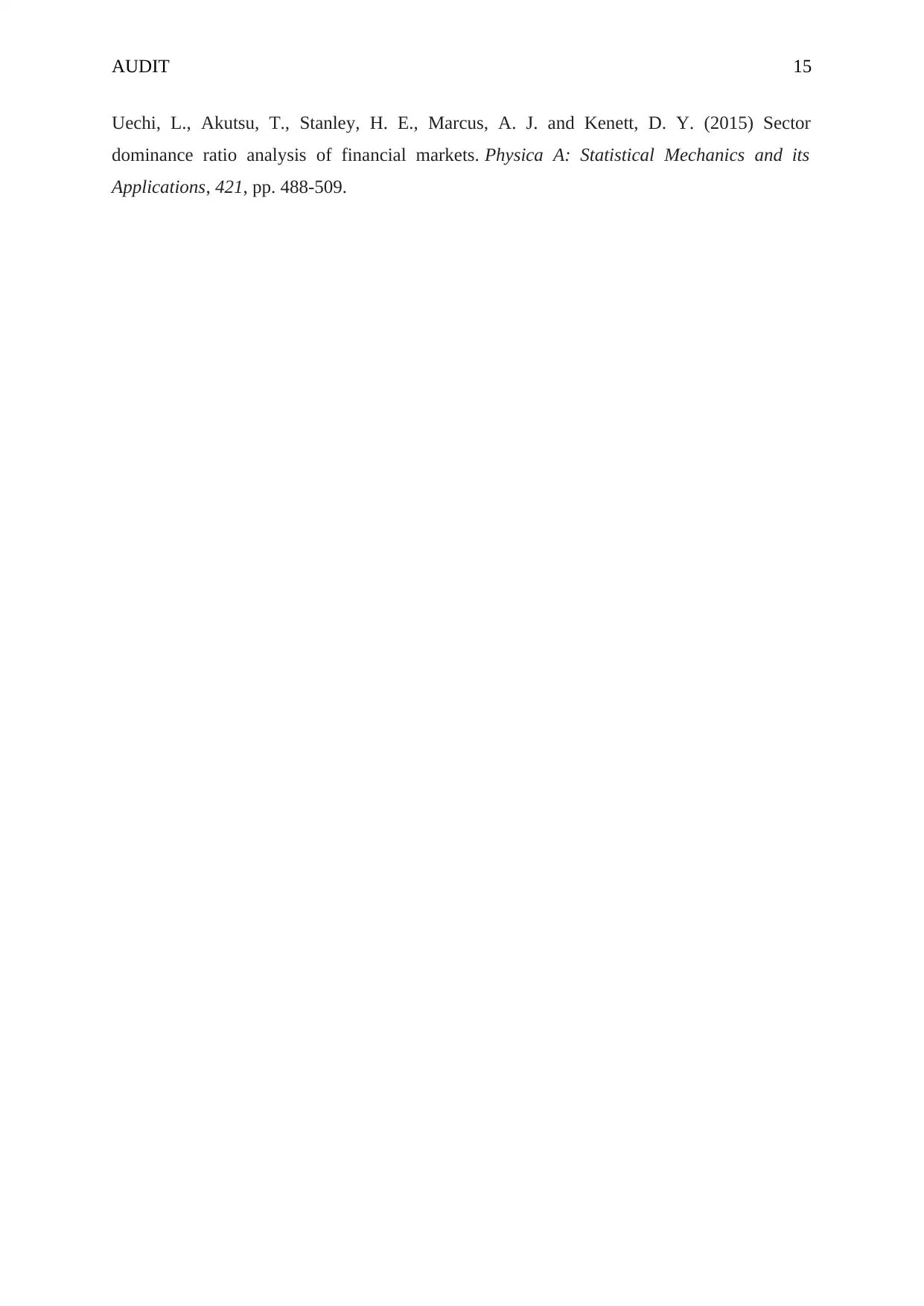
AUDIT 15
Uechi, L., Akutsu, T., Stanley, H. E., Marcus, A. J. and Kenett, D. Y. (2015) Sector
dominance ratio analysis of financial markets. Physica A: Statistical Mechanics and its
Applications, 421, pp. 488-509.
Uechi, L., Akutsu, T., Stanley, H. E., Marcus, A. J. and Kenett, D. Y. (2015) Sector
dominance ratio analysis of financial markets. Physica A: Statistical Mechanics and its
Applications, 421, pp. 488-509.
1 out of 16
Related Documents
Your All-in-One AI-Powered Toolkit for Academic Success.
+13062052269
info@desklib.com
Available 24*7 on WhatsApp / Email
![[object Object]](/_next/static/media/star-bottom.7253800d.svg)
Unlock your academic potential
© 2024 | Zucol Services PVT LTD | All rights reserved.





